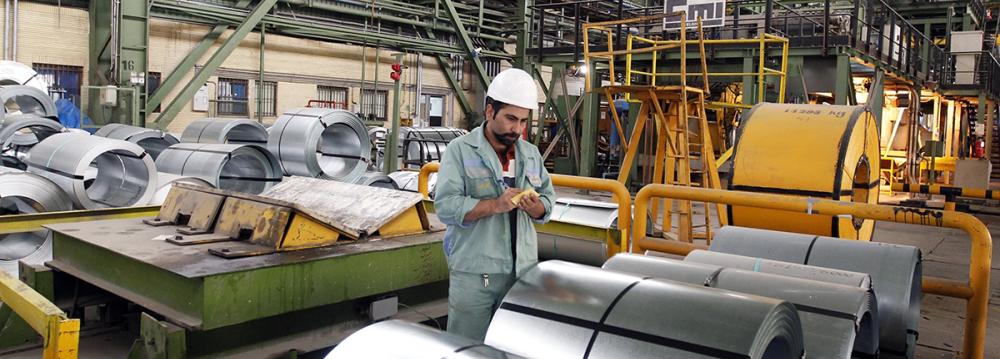Iran is among countries the European Union has threatened to hit with tariffs to check their exports of hot-rolled flat iron and alloy and non-alloy steel products to the continent.
Other countries facing EU’s preventive measures include Russia, Ukraine, Serbia and Brazil which are accused of selling their steel products at cheap prices in Europe.
The European Steel Association (Eurofer), whose members account for more than a quarter of EU iron and steel products, triggered the case in a May complaint. The European Commission’s probe is set to focus on the period July 1, 2015 to June 30, 2016.
Anti-dumping procedure was started because, according to the complaint submitted to the European Commission, Eurofer on behalf of producers “provided evidence that imports of the product under investigation from the countries concerned have increased overall in absolute terms and in terms of market share,” and that “the volume and the prices of the imported product under investigation have had, among other consequences, a negative impact on the quantities sold, the level of prices charged and the market share held by the Union industry.”
According to the text of the Eurofer’s complaint, the alleged dumping resulted in “substantial effects on the overall performance, the financial situation and the employment situation of the Union industry.”
The hot-rolled coil market in Europe is worth about $11.1 billion. The key product is used in everything from cars to construction and is a monopoly of such companies as ArcelorMittal and ThyssenKrupp.
The EU, which can impose duties on imports if there is evidence that these are sold at below fair market prices and are damaging the businesses of European competitors, now has 10 anti-dumping investigations underway into steel products.
The commission has nine months to decide whether to impose anti-dumping duties for six months and 15 months to decide whether to apply “definitive” levies for five years.
However, certain facts cast a shadow of doubt on Eurofer’s true intentions regarding the complaint. For instance, China, the world’s largest steelmaker and the agent of chaos in nearly every market around the globe is absent from EU’s list of dumping allegations. Moreover, Iran, Serbia and Ukraine’s meager steel exports to EU do not meet the basic requirements of engaging in dumping strategies.
Not Capable of Dumping
According to the managing director of Khuzestan Oxin Steel Company, most of Iran’s steel output is consumed domestically and only a fraction is exported.
“These allegations do not hold water, considering that one of the requirements of engaging in [profitable] dumping is for the output to significantly exceed domestic demand,” SMT daily quoted Aziz Qanavati as saying.
According to the London-based business intelligence company CRU Group’s Steel Sheet Market Outlook, Iran is the 14th largest consumer of steel sheet products in the world, with an apparent consumption of 7.3 million tons in 2015. Over a five-year period ending in 2020, Iran is seen to be one of the fastest growing steel sheet markets amongst the top 20 steel sheet consuming nations in the world. The country’s steel sheet consumption growth is forecast to be more than double the world average over 2015-2020.
Iran’s crude steel output stood at about 16 million tons over the past Iranian year that ended in March, and Iranian steel mills exported over 4 million tons of steel products during the period, 1.7 million tons of which were flat rolled products.
This is while the primary motive of a country that engages in dumping is to disarray the target market, slowly drive the competitors out of business, and eventually reap the benefits of an uncontested market. Such a practice requires a dependable, sustained and growing excess production.
Considering the growing demand at home, Iran is simply incapable of dumping.
Qanavati believes the complaint is only meant to impede Iran’s entry into the European steel market as part of a classic “trade war” move. And even if the complaint goes through and tariffs are imposed, “Iran’s steel industry would not be hurt as the European market accounts for a small portion of Iranian steel exports.”
The head of Iran Steel Producers Association surmises that the EU’s main targets in the anti-dumping procedure are Brazil and Russia, whose productions enable them to actually disrupt the continent’s markets. The presence of Iran, Ukraine and Serbia on the list, according to Rasool Khalife-Soltani, serves just as a tool to avoid politicizing the issue and targeting different countries along the spectrum.
Echoing the same remarks, Nematollah Mohseni says Iran is actually being used as a scapegoat in this conflict.
“There would have been a long-standing political feud between the EU and China if they started pointing fingers at each other directly,” said the steel market expert.
The EU and China’s trade war is in fact taking place under the radar. The union has already levied huge duties on Chinese rolled products, and China, in order to skirt the bulwark, has embarked on purchasing steel mills inside Europe, such as in Serbia.
Back in May, the Chinese HeSteel officially took over Serbia’s sole steel mill in Smederevo, by paying the agreed price of €46 million euros and announcing plans to invest at least €300 million to turn it into one of the most competitive steel mills in Europe.


